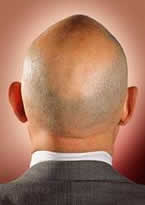TEN BEST THINGS YOU CAN DO TO YOUR HAIR
24.04.2008 in HAIR LOSS FACTS1. Maintain a healthy scalp.
The scalp’s condition determines the strength, density, and life span of our hair. Massage the scalp with your fingertips for five minutes every day to promote blood circulation in the scalp. This light pressure also stimulates the oil glands in the scalp and makes them work more efficiently in producing natural oils for the hair. Regular stimulation of the scalp increases blood supply and brings nourishment to hair follicles, which in turn helps prevent hair loss and supports the natural development of healthy hair.
2. Use a separate shampoo and conditioner instead of one-step “conditioning shampoos.”
Although conditioning shampoos may be more convenient and time-saving, shampoos and conditioners used separately are much more effective in maintaining healthy and beautiful hair. The two hair products work best as a two-step process: The shampoo cleanses the hair by removing oils secreted by the scalp and other particles like dirt and pollution that build up in the hair. Then, after the hair has been thoroughly cleansed, conditioner is applied to close and smoothen the outermost layer of the hair shaft. This locks in moisture within the hair, while also coating each strand to protect it against environmental pollutants and other damaging elements.
3. Use products specifically made for chemically-treated (colored, straightened, permed) hair.
Chemically-treated hair has undergone changes within the hair shaft, and regular shampoos and conditioners may not have what it takes to address this type of hair’s special needs. Not only will specialized products help your hair regain the moisture lost in chemical treatments, they will also make the results of the treatment last longer. For instance, hair care products for colored hair contain ingredients that preserve the vibrant color of hair, while products for permed hair help maintain the bounciness of curls.
4. Cleanse your hair with a clarifying shampoo once a week.
There is a popular belief that any brand of shampoo stops working after several weeks of use, and that one should switch brands every once in a while. The truth of the matter is that the resulting hair dullness after using the same shampoo for some time is actually caused by a buildup of particles (such as conditioners or styling products) that weigh down your hair and make it look limp and lackluster with regular use. Instead of using multiple shampoo brands, keep one clarifying shampoo in your bathroom and use it once a week. Clarifying shampoos contain an elevated acid content that is very effective in removing buildup in the hair and scalp.
5. Nourish your hair from within by taking vitamins and hair supplements.
A healthy body results in a healthy scalp—and in turn, healthy hair. Make sure to take your daily dose of vitamins A, C, and E, which benefit the hair in different ways. Vitamin A aids in the production of healthy sebum in the scalp while Vitamin C has an antioxidant effect that is essential in maintaining beautiful hair. Vitamin E helps enhance scalp circulation, leading to healthier hair follicles.
6. Know your hair and scalp type, and use the appropriate hair care products.
Different hair types have different needs. Before buying any hair care product, make sure that you know your hair type (normal, fine, thick, frizzy, damaged) and your scalp type (normal, oily, dry, sensitive). A well-trained hairdresser should be able to diagnose your hair and scalp and recommend reliable products that will address your specific concerns.
7. Protect your hair against sun damage.
The skin isn’t the only part of your body that needs protection from the sun’s harmful rays. UVA and UVB rays damage the hair cuticle the same way as bleach, which leads to dry, brittle, and weak hair. During these summer months, shield your hair from damage by wearing a scarf or a hat when going under the sun or by applying a product that contains a sun protection factor (SPF).
8. Moisturize your hair before and after swimming.
Chlorine and salt water strip moisture from your hair. Applying conditioner or a serum treatment before jumping into the water will coat the hair and act as a protective barrier against chlorine and salt water. These damaging particles collect outside the hair and can be easily shampooed off after your swim. Still, treat your hair to a deep conditioner or a masque after swimming to strengthen it and help it regain any lost moisture.
9. Choose a haircut that complements your face shape and a color that complements your skintone.
Not everyone can carry a Rihanna layered cut or a Victoria Beckham bob, but for sure there’s a hairstyle out there that will suit you best. A well-trained hairdresser should be able to assess your face shape —is it oval, long, round, square, or heart-shaped—and recommend particular hairstyles that flatter it. A good haircut should emphasize your best features, like your eyes, your cheekbones, or your chin; it should also downplay your flaws, like an overly angular jaw for square faces.
Choose hair color that complements your skintone to minimize flaws and bring out the best in your complexion. Picking the wrong shade can make your overall appearance look tired, dull, or unnatural. First, determine whether your skintone is warm (with gold or peach undertones) or cool (with pink undertones). Warm tones look best with reddish, orange, and golden casts, while cool tones are complemented by shades of ash brown, ash blonde, and black. When in doubt, consult your hairdresser on the colors that would look best with your skintone.
10. Trim your hair every two months.
Even if you’re growing your hair long, keep it beautiful by getting it trimmed every six to eight weeks. The ends of the hair are the most damaged part since they are most exposed to the sun, wind, shampoos, chemical treatments, pollutants, and a variety of other factors for the longest time. Regular trims will help prevent split ends, frizzy, frayed strands, and thinning at the ends of your hair. If you still want to keep your tresses long, trim at least an inch off your hair, keeping in mind that that inch of hair is the most mistreated and damaged part of your hair, and is just about ready to retire anyway. (L’Oréal tips)
Do you have Hair Loss Problems, read our Hair Loss Help







